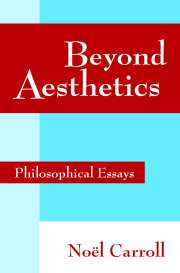Book contents
- Frontmatter
- Contents
- Foreword by Peter Kivy
- Introduction
- PART I BEYOND AESTHETICS
- PART II ART, HISTORY, AND NARRATIVE
- PART III INTERPRETATION AND INTENTION
- Art, Intention, and Conversation
- Anglo-American Aesthetics and Contemporary Criticism: Intention and the Hermeneutics of Suspicion
- The Intentional Fallacy: Defending Myself
- Interpretation and Intention: The Debate between Hypothetical and Actual Intentionalism
- PART IV ART, EMOTION, AND MORTALITY
- PART V ALTERNATIVE TOPICS
- Notes
- Index
Anglo-American Aesthetics and Contemporary Criticism: Intention and the Hermeneutics of Suspicion
Published online by Cambridge University Press: 19 January 2010
- Frontmatter
- Contents
- Foreword by Peter Kivy
- Introduction
- PART I BEYOND AESTHETICS
- PART II ART, HISTORY, AND NARRATIVE
- PART III INTERPRETATION AND INTENTION
- Art, Intention, and Conversation
- Anglo-American Aesthetics and Contemporary Criticism: Intention and the Hermeneutics of Suspicion
- The Intentional Fallacy: Defending Myself
- Interpretation and Intention: The Debate between Hypothetical and Actual Intentionalism
- PART IV ART, EMOTION, AND MORTALITY
- PART V ALTERNATIVE TOPICS
- Notes
- Index
Summary
INTRODUCTION
The fiftieth anniversary of the American Society for Aesthetics comes at a time of ostensible turmoil in academia. Many fields of inquiry – so many, in fact, that it would be cumbersome to enumerate them – claim to be undergoing fundamental identity crises; old paradigms are declared outmoded on every side, and new approaches heralded. In such a context, contemplating the health of Anglo-American-style aesthetics is natural. Indeed, since our colleagues in adjacent fields – including literary theory, film studies, art history, and so on – seem convinced that if aesthetics is not dead, then it should be killed, we might spend some of this anniversary not only celebrating the past, but also worrying about the future.
The charges arrayed against Anglo-American aesthetics at present are legion. One could not hope to identify, let alone to address, them all in such a brief note. Thus, I will focus on just one issue in order to demonstrate that not only is Anglo- American aesthetics not always at loggerheads with contemporary art criticism, but that contemporary criticism may even profit from the insights of aesthetics.
Like the art of the past decade or so, contemporary criticism has become increasingly political in its orientation. One aspect of this is the familiar interpretation of artworks – often indiscriminately called “texts” – for their symptomatic political content, including especially: latent or repressed sexism, racism, classism, imperialism, and so forth.
Moreover, at the same time that contemporary critics have opted for this variety of the hermeneutics of suspicion, a movement reinstating the relevance of the artist's intentions for interpretation has begun to take hold among philosophers of art.
- Type
- Chapter
- Information
- Beyond AestheticsPhilosophical Essays, pp. 180 - 190Publisher: Cambridge University PressPrint publication year: 2001
- 1
- Cited by



